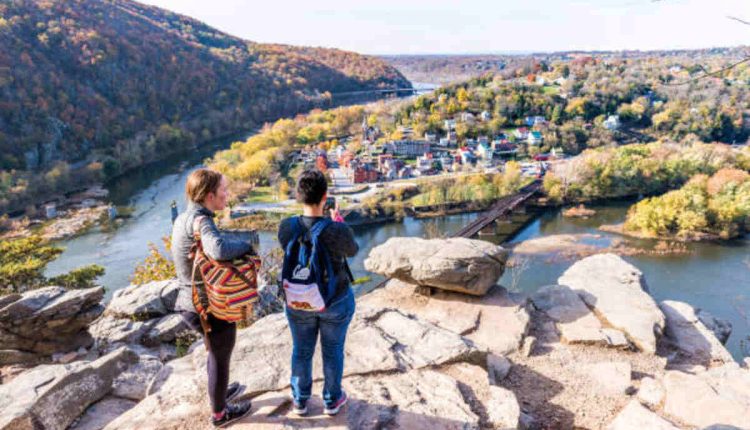The Shenandoah River winds its way through Virginia’s countryside, meeting at Front Royal before continuing for nearly 150 miles before merging with the Potomac near Harpers Ferry, West Virginia.
The Shenandoah Valley boasts numerous tourist attractions, such as Shenandoah National Park and George Washington National Forest. Its fertile soil made it an attractive location for early settlers; furthermore, its limestone underlay and karst topography resulted in numerous caves.
About the Map
The Shenandoah River is a favorite spot for canoeing and river tubing enthusiasts, drawing thousands of people every summer to the South Fork of this river. Twenty public access points allow visitors to plan trips of varying lengths. Furthermore, its use as a transportation artery connects Shenandoah National Park with George Washington National Forest land.
Over millions of years, the Shenandoah River and its tributaries carved their way through limestone bedrock to form expansive floodplains perfect for growing food. Along its course, water collected and released rock particles in serpentine shapes known as meanders that had serpentine bends like U-shapes that formed along their course – creating meanders.
Shenandoah River in Southwestern Virginia stands out as being unique because it flows north, unlike most rivers that flow south (Holston River, Clinch River, and Powell River) or west (Levisa Fork and New River) towards Ohio River or Mississippi and Gulf of Mexico. This anomaly can be explained by the Eastern Continental Divide, which divides water flows so raindrops falling on one side will drain into the Atlantic Ocean while those falling on the other will go to the Mississippi River basin.
Shenandoah National Park lies along the Blue Ridge Mountains’ crest, boasting many headwater streams that drain into the Shenandoah River or its tributaries and serve as a critical habitat for trout species and economic activities that attract visitors to Shenandoah National Park.
North Fork of the Shenandoah River
The North Fork of the Shenandoah River in Virginia is an idyllic waterway and one of the region’s premier destinations for canoeing and kayaking, offering scenic stretches through farmland and small towns against a stunning mountain backdrop. Additionally, this stretch hosts various wildlife species like smallmouth bass fishery.
The North and South Forks of the Shenandoah River meet near Front Royal, VA, before flowing north through Shenandoah Valley until meeting up with Potomac at Harper’s Ferry, West Virginia. Together, they cover an area of 2,937 square miles, including Frederick County in Virginia, Augusta and Rockingham Counties, and Page County in West Virginia.
The Shenandoah River’s geological history dates back 500 million years to the Cambrian Period, during which layers of sandstone and shale began accumulating along an ancient precursor of North America. A collision between continents caused fractures to form near Massanutten Mountain, which ultimately defined its current course through Virginia.
The North Fork of the Shenandoah provides recreational opportunities such as fishing, swimming, paddling, and hiking; however, certain sections are subject to harmful algal blooms (HAB). To address this challenge, SRK and Downstream Project have collaborated with Shenandoah County on engaging community members in the “Respect the Shenandoah” Campaign, which identifies hotspots of HABs across their watershed and works toward improving conditions overall.
South Fork of the Shenandoah River
The South Fork of the Shenandoah River flows 97 miles north from its confluence with the North River near Port Republic to join its main stem in Front Royal, draining a watershed covering 1,650 square miles and receiving surface runoff from the Western slopes of Massanutten Mountain, parts of Blue Ridge Mountains, and groundwater from karst regions. As a fifth-order river with bedrock substrate and abundant stretches of calm water, it makes a famous recreational river with several commercial outfitters offering rentals or guided trips along its course.
South Fork of the Shenandoah River is well known as an ideal spot for paddling, but fly fishers also flock here for smallmouth bass fishing with various fly patterns – particularly effective when targeting these popular game fish near deep ledges and riffles.
The South Fork River provides stunning mountain views, easy access, camping opportunities for both public and private camping, boat rental and guide services, and numerous outfitters offering boat rentals and guides. Popular activities on this river include canoeing, river tubing, white-water recreation (class I-III in season), and canoe polo. On summer weekends below Luray, it can become overrun with hundreds of rental canoes paddling by city-weary Washington visitors who bump and splash their way downriver.
Page Valley
Page Valley, which lies between Shenandoah National Park and Luray Caverns on one side and the South Fork of the Shenandoah River on the other, is famous for its picturesque four-season landscape and numerous opportunities for outdoor recreation and relaxation. It offers visitors stunning seasonal vistas along with plenty of opportunities for fresh-air relaxation and recreation.
South Fork River is an ideal setting for canoeists and kayakers to test their skills on Class I and II rapids, creating plenty of opportunities to put your paddling or kayaking abilities through its paces. Furthermore, its solid rock bottom creates riffles and small rapids – providing an ideal habitat for numerous species of fish species that occupy it.
Experience the South Fork River through one or more of its many activities – canoeing, rafting, or relaxing along its shoreline, which can all provide pleasures of relaxation, while hiking upstream of rapids can be exciting! Be aware of its popularity during the summer and fall months to avoid missing out.
Page Valley boasts an active Downtown, a nationally renowned wine trail, and miles of pristine river, making it the perfect place for everyone. Home to over 600 unique short-term vacation rentals from rustic river hideaways and mountaintop retreats to charming cottages and classic log cabins, romantic getaways, family reunions, or weekend trips–Page Valley lodging options can accommodate them all!


